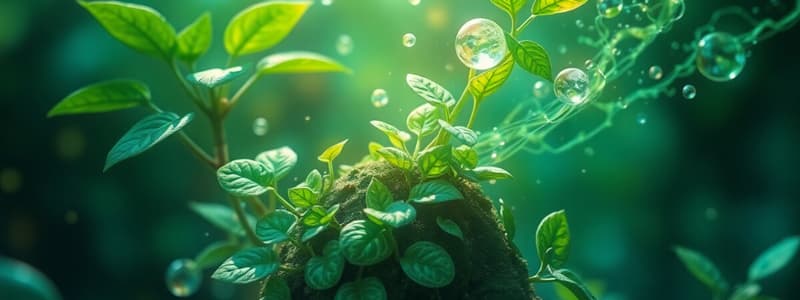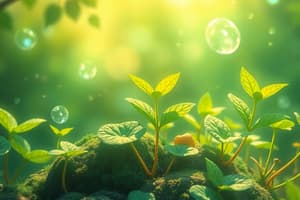Podcast
Questions and Answers
In the chemical equation for photosynthesis, which of the following accurately describes the roles of carbon dioxide and water?
In the chemical equation for photosynthesis, which of the following accurately describes the roles of carbon dioxide and water?
- Carbon dioxide is a reactant, while water is released as a byproduct.
- Water is a reactant, and carbon dioxide is released as a byproduct.
- Both carbon dioxide and water are products formed as a result of photosynthesis.
- Both carbon dioxide and water are reactants needed to produce glucose. (correct)
During photosynthesis, the light-dependent reactions and light-independent reactions occur in different parts of the chloroplast. Where do these stages primarily take place?
During photosynthesis, the light-dependent reactions and light-independent reactions occur in different parts of the chloroplast. Where do these stages primarily take place?
- Light-dependent reactions occur in the stroma, and light-independent reactions occur in the granum.
- Both stages occur in the granum of the chloroplast.
- Both stages occur in the stroma of the chloroplast.
- Light-dependent reactions occur in the granum, and light-independent reactions occur in the stroma. (correct)
The first stage of photosynthesis is described as 'light-dependent' because it directly relies on sunlight for a crucial step. What is the primary role of sunlight in this stage?
The first stage of photosynthesis is described as 'light-dependent' because it directly relies on sunlight for a crucial step. What is the primary role of sunlight in this stage?
- Sunlight is used to break down glucose molecules to release energy.
- Sunlight provides the energy to convert carbon dioxide into glucose.
- Sunlight directly facilitates the uptake of carbon dioxide through the stoma.
- Sunlight's energy is captured by chlorophyll and used to split water molecules. (correct)
Glucose produced during photosynthesis is a form of stored energy. How does a plant primarily access and utilize the energy stored in glucose?
Glucose produced during photosynthesis is a form of stored energy. How does a plant primarily access and utilize the energy stored in glucose?
While plants are well-known for photosynthesis, other organisms also perform this process. Which of the following groups includes organisms capable of photosynthesis, besides plants?
While plants are well-known for photosynthesis, other organisms also perform this process. Which of the following groups includes organisms capable of photosynthesis, besides plants?
During the first stage of photosynthesis, what key processes occur within the plant?
During the first stage of photosynthesis, what key processes occur within the plant?
In the photosynthesis equation $6H_2O + 6CO_2 \rightarrow C_6H_{12}O_6 + 6O_2$, what do $C_6H_{12}O_6$ and $6O_2$ represent respectively?
In the photosynthesis equation $6H_2O + 6CO_2 \rightarrow C_6H_{12}O_6 + 6O_2$, what do $C_6H_{12}O_6$ and $6O_2$ represent respectively?
If a plant were placed in an environment devoid of carbon dioxide, how would this affect its ability to perform photosynthesis?
If a plant were placed in an environment devoid of carbon dioxide, how would this affect its ability to perform photosynthesis?
What is the crucial role of chlorophyll in the process of photosynthesis?
What is the crucial role of chlorophyll in the process of photosynthesis?
Why are the products of photosynthesis crucial for both the plant and other life forms?
Why are the products of photosynthesis crucial for both the plant and other life forms?
Flashcards
Photosynthesis
Photosynthesis
The process plants use to convert light energy into sugar, using carbon dioxide and water.
Chlorophyll
Chlorophyll
Green pigment in plant cells that allows plants to convert light energy.
Reactants of Photosynthesis
Reactants of Photosynthesis
Water, carbon dioxide, and sunlight which are required for photosynthesis to happen.
Products of Photosynthesis
Products of Photosynthesis
Signup and view all the flashcards
Photosynthesis Equation
Photosynthesis Equation
Signup and view all the flashcards
Chemical Equation
Chemical Equation
Signup and view all the flashcards
Reactants
Reactants
Signup and view all the flashcards
Products
Products
Signup and view all the flashcards
Chloroplast
Chloroplast
Signup and view all the flashcards
Autotroph
Autotroph
Signup and view all the flashcards
Study Notes
- Photosynthesis is how plants convert light energy from the sun into sugar, using carbon dioxide and water.
- Oxygen is created as a result of the above process
Photosynthesis Explained
- Photo, from the Greek word for light, plus synthesis, meaning combining things, defines photosynthesis as "to put together with the help of light".
- Chlorophyll, a green pigment in plant cells' chloroplasts, enables the conversion of light energy.
The Process
- Photosynthesis occurs in two stages, converting water, carbon dioxide, and sunlight into energy the plant can use
- Chlorophyll converts the light energy from the sun into energy the plant uses.
- Next the plant then uses this energy to break the bonds of the water and carbon dioxide molecules, then uses the atoms to build glucose and oxygen molecules.
Stage One
- Reactants like water, carbon dioxide, and sunlight enter plant cells where chlorophyll absorbs sunlight.
- Radiant energy transforms into chemical energy, NADPH and ATP.
- Water molecules break into hydrogen and oxygen atoms; some energy is stored for stage two.
Stage Two
- Energy breaks carbon dioxide bonds.
- Hydrogen and oxygen atoms from water, plus carbon and oxygen atoms from carbon dioxide, create glucose molecules.
- Oxygen is released as waste into the atmosphere, glucose becomes food for the plant
Photosynthesis Equation Defined
- 6H₂O + 6CO₂ → C₆H₁₂O₆ + 6O₂ models photosynthesis.
- H₂O - water, CO₂ - carbon dioxide, C₆H₁₂O₆ - glucose, O₂ - oxygen molecule.
- Six water and carbon dioxide molecules create one glucose molecule and six oxygen molecules.
- Water, carbon dioxide, and sunlight are the reactants that react to form glucose and oxygen.
Location of Photosynthesis
- The two stages occur in a plant cell's chloroplast.
- Chloroplasts, unique to plant cells, contain chlorophyll.
- Chlorophyll, a pigment molecule, absorbs light and gives plants their green color.
- Water and carbon dioxide enter the chloroplast, where chlorophyll in the granum absorbs sunlight.
- Stage one is light dependent, stage two is light independent.
- Photons break water bonds in stage one, releasing oxygen through stoma and some become hydrogen atoms.
- ATP energy breaks carbon dioxide bonds and builds glucose molecules in the stroma.
Products Defined
- Glucose and oxygen are produced.
- Oxygen releases through stoma.
- Glucose, a sugar, stores chemical energy that is broken down during cellular respiration.
Photosynthesis in Other Organisms
- Autotrophs make their own food; heterotrophs must find food.
- Plant-like protists and cyanobacteria also photosynthesize.
- Protists' plastids contain light-absorbing pigment molecules and can lead to different algae colors.
- Cyanobacteria uses the same reactants and products as plants
- Bacteriochlorophyll aids bacteria in creating food
Studying That Suits You
Use AI to generate personalized quizzes and flashcards to suit your learning preferences.




